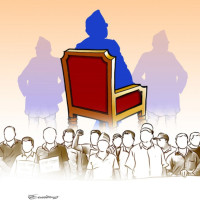Columns
Coming full circle
The Ram Temple movement dealt a lethal blow to Indian National Congress.
Ishan Joshi
Nearly 27 years to the day when as a raw 20-year-old political reporter for The Statesman I reached Ayodhya to cover the run-up to and, as it happened, the aftermath of the demolition of a medieval mosque on 6 December 1992, my primary concern was to find out whether I would get eggs for breakfast.
Information I had picked up on the drive down from the state capital Lucknow to Ayodhya was that the temple town, in keeping with its status as a holy city, did no “non-veg.”
Such things were important to me, then.
Now, in an effort to prolong my late youth, as it were, oats/idli/low-fat yogurt and the like are my victuals of choice for breakfast.
But that’s not all that’s changed.
The Supreme Court’s verdict in the Ayodhya Case last week means a Ram Temple will soon be built at what most Indians believe was Lord Ram’s janmasthaan (birthplace). On the exact spot where the mosque stood till it was demolished as I took notes on that December afternoon all those years ago.
Whichever side of the argument one is on, it is clear that Ayodhya’s landscape, indeed its skyline, is set to change irrevocably.
But it is the changes wrought on the political-social landscape over the past three decades when former BJP leader and Deputy Prime Minister LK Advani first put the Ram Temple issue on the agenda of the party in 1989 which interest us here.
Ayodhya’s impact on the BJP which moved from a fringe party with just two seats in Parliament to its current place of pre-eminence in the Indian polity and its consequences for India’s nearly 200 million Muslim citizens have rightly been examined at length and in great depth.
The effect the movement for a Ram Temple had on the Congress Party and how it informed the narrative of the majority Hindu community, therefore, is the focus of this short essay.
Political Loser
The Ram Temple movement dealt a lethal blow to India’s Grand Old Party.
The ideologically dilapidated, organisationally weak and often directionless Congress we see today as a shrunken, shrill principal Opposition party can be traced directly to its inability to formulate a cogent response to the first genuine ideological challenge it faced.
The Congress, as the big tent party of the freedom struggle, had - apart from a two-year blip in the 1970s in the aftermath of the ill-advised Emergency declared by Indira Gandhi - governed the country since Independence in 1947.
Administratively, it had effectively grafted on to British colonial structures an elite-led statist/socialist superstructure. With the best of intentions, perhaps.
What this meant, however, was the continuation of the client-patron relationship between citizens and the state. Or the state as mai-baap (mother-father), in the vernacular. It was what the political scientist Rajini Kothari famously termed the ‘Congress System’.
The only real ideological challenge to the Congress in the first three decades of Independence came from the Indian Left but by the 1970s Indira Gandhi had comprehensively ‘out-Marxed the Marxists’ in many ways, including nationalising banks and abolishing erstwhile rajahs’ privy purses.
By the late 1980s, though, when the brute majority won by her son and former Prime Minister Rajiv Gandhi riding on a sympathy wave following her assassination in 1984 had dissipated in the 1989 general election, the continuation of rickety state structures and their inability to meet the rising aspirations of the people was untenable.
This was not lost on so-called modernisers in the Congress including Rajiv Gandhi who set about the economic reforms process which were finally ushered in 1991 on former Prime Minister PV Narasimha Rao and his then Finance Minister Manmohan Singh’s watch.
But they all failed to simultaneously grasp the challenge thrown up by a robust articulation of an Indic cultural nationalism using the demand for a Ram Temple at Ayodhya as its potent symbol.
Leaden-footed, and more used to taking on the Left than the ‘Right’ (though it’s not unproblematic to term the BJP as such), the Congress reacted by lurching to a fundamentalist secular position sans cultural context.
It had, by then, anyway long since snuffed out the traditional voices within a party which now swore by Nehruvian socialism, whatever that may mean.
In the days of the big tent Congress, these voices from within the fold had argued for an understanding of India premised on an Indic civilizational ethos which was both inclusive and receptive to notions of modernity.
Nehru himself had listened to them with respect even when he disagreed with them. But nearly all of them died years before him and he pushed through his agenda largely unchecked and at times by sheer force of personality alone.
Suffused with a sense of Nehru-Gandhi dynasty worship because the family were still winning them elections till the late 1980s, the Congress watched with a near-criminal indifference as the BJP not only gained traction for its idea of India but appropriated the legacy of Congress icons to their cause.
India’s first Deputy Prime Minister Sardar Vallabhbhai Patel, its first President Rajendra Prasad, its last Governor-General C Rajagopalachari amid countless others became part of the BJP’s construction of an alternative national discourse premised on the demand for a Ram Temple at the birthplace of a God-King and seventh incarnation of Vishnu as a symbol of national pride.
The plaintive cry by current Congress president Sonia Gandhi in the 2019 election campaign that the BJP had “successfully painted the Congress as a party of Muslims” is emblematic of the permanent damage she and her predecessors have done to the erstwhile ruling party of India.
Not only did they not have anything original to say in response to the ideological challenge of the BJP over the past three decades, they failed even to understand the significance of what the Ram Temple movement came to symbolise. That it was larger than the sums of its parts and a vital cog in an albeit not unproblematic muscular-liberal, Indic national narrative of the BJP.
Hindu Divided Family
Indian Muslims have, save those on the extremes, gracefully accepted the Supreme Court’s verdict on Ayodhya.
As a large, 170-million strong minority community more open now than ever before to the Indian state’s integrationist approach, Muslims have shown a collective desire to move on from the vandalism of 6 December 1992 when the 16th century Babari Mosque was demolished by their frenzied fellow citizens.
It is the Hindu community of over 960 million which comprises over 80% of India’s population that has much to ponder over.
The apex court judgement may have put a quietus on the matter legally and there is a clearly discernible sense of closure among a vast section of Hindus.
But there are those who will not matters rest and let the country focus on developing a sense of civic nationalism premised, as has already de facto been established, on a non-supremacist Indic ethos.
Not to mention work on economic growth for a burgeoning, aspirational population which will have an average age of just 29 by 2020.
The progenitor of the Ram Temple movement himself, LK Advani, in a series of interviews to this writer over a five-year period in the late 1990s-early 2000s, had said that what worried him most about being at the head of “the largest mass mobilisation in Independent India” was the lumpen element.
Though he said the BJP was trying to ensure the lumpen were isolated, he conceded that any agitation of scale would have to deal with the danger of rampant lumpenisation.
That is the spectre which now haunts India’s Hindu community.
In the aftermath of the Ayodhya verdict, Hindu triumphalism has as of yet been thankfully conspicuous by its absence. But there’s no guarantee matters will continue like this despite appeals by community leaders.
A sotto voce campaign that resurrects a provocative slogan from the peak of the Ram Temple movement has resurfaced – Ayodhya to bas jhaanki hai, Mathura Kashi baaki hai (Ayodhya is only the trailer, construction of a Krishna temple in Mathura and Shiva temple in Kashi (Varanasi) on which mosques were built are on the agenda too).
It’s this sort of incendiary stuff which the Narendra Modi administration and its ideological guides know has the potential to tear apart Hindu society which they have spent decades in trying to unify.
Looking Ahead
Within the Hindu community, thankfully, there is no stomach for another long drawn out battle of attrition in the courts and on the streets as everyday governance issues take precedence. At the moment.
The emotive tug of temples to Lords Shiva and Vishnu which were demolished and/or built over by medieval Muslim monarchs to ‘humiliate Hindus’ would, however, only be underestimated by the context-free and culturally oblivious.
Yes, for the foreseeable future, it’s highly unlikely that any such agenda will find acceptance or traction among largely moderate Hindus.
There is, in any case, a reference in the Supreme Court verdict to the Places of Worship Act 1991 which declared that apart from the Ayodhya dispute, the religious character of a place of worship existing on the day of India’s Independence shall continue to be the same as it existed on that day.
But stranger things have occurred in Indian politics than a violation of the law.
If, in the future, distant or otherwise, a demand is raised or arises for temples at Mathura and Kashi, there is only one decent, civilised response which the Hindu community must collectively express: Any such movement must be led and populated only by their Muslim co-citizens.
If no such move is forthcoming, then so be it. Status quo must prevail.
And there must be no clamour from India’s Hindus and/or organisations who purportedly speak for them.
Because, as I found out 27 years ago, I could tuck into pure vegetarian fare at Ayodhya while working all day sustained by the three-egg omelette for breakfast I’d happily had in Faizabad - they are contiguous twin cities, after all.
This article is part of the Asian Editors’ Circle from the Asia News Network.




 17.12°C Kathmandu
17.12°C Kathmandu















